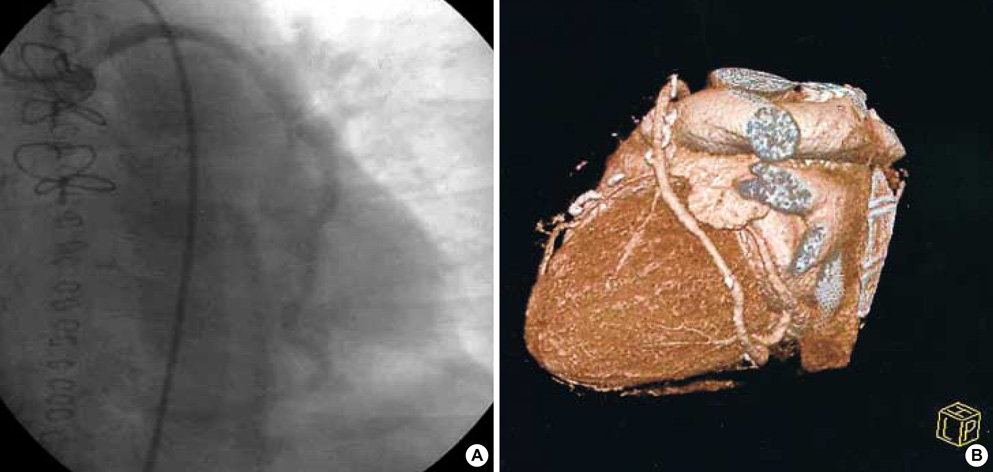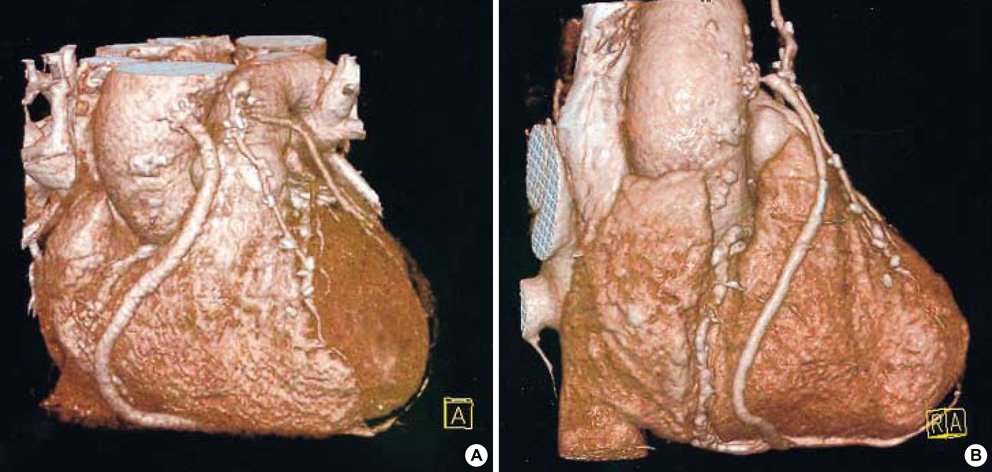J Korean Med Sci.
2006 Oct;21(5):849-853. 10.3346/jkms.2006.21.5.849.
Mid-Term Follow Up of Patients Using The St. Jude Medical Aortic Connector System for Proximal Vein Graft in CABG
- Affiliations
-
- 1Department of Thoracic and Cardiovascular Surgery, Asan Medical Center, University of Ulsan, College of Medicine, Seoul, Korea. jwlee@amc.seoul.kr
- KMID: 1781904
- DOI: http://doi.org/10.3346/jkms.2006.21.5.849
Abstract
- The aortic connector system may reduce stroke during proximal venous anastomosis. However, the overall anastomotic patency rate has been generally reported to be low. From October 2002 to March 2004, 68 patients who received proximal anastomosis using the St. Jude Aortic Connector System were included in the study. There were 47 men and 21 women and their mean age was 65.68+/-6.68 yr old (52 to 85 yr). Grafts were evaluated by coronary angiography or multi-slice 16 channel 3-D CT at 6 days and at 6 months postoperatively. In the immediate postoperative period, no stenosis was observed by either angiography (n=22) or 3D CT (n=46). At 6-month postoperatively, we performed either angiography (n=7) or 3-D CT (n=52). Of these patients, 5 patients showed graft stenosis in the midportion, and 3 in the ostium. There were no stroke. Simple, and effective proximal anastomosis with good protection from cerebrovascular accident was achieved especially when calcification or atheromatous plaque was observed at the ascending aorta in the operation room. However, our mid term patency results raise concerns related to venous graft stenosis in the midportion. Therefore, longer follow up is recommended.
MeSH Terms
Figure
Reference
-
1. Mack MJ, Emery RW, Ley LR, Cole PA, Leonard A, Edgerton JR, Dewey TM, Magee MJ, Flavin TS. Initial experience with proximal anastomoses performed with a mechanical connetor. Ann Thorac Surg. 2003. 75:1866–1871.2. Calafiore AM, Bar-El Y, Vitolla G, Giammarco G, Teodori G, Iaco AL, D'Alessandro S, Mauro MD. Early clinical experience with a new sutureless anastomotic device for proximal anastomosis of the saphenous vein to the aorta. J Thorac Cardiovasc Surg. 2001. 121:854–858.
Article3. Hornik L, Tenderich G, Minami K, Fassbender D, Schulz TO, Beinert B, Koerfer R. First experience with the St. Jude medical inc. Symmetry bypass system (Aortic Connector System). J Thorac Cardiovasc Surg. 2003. 125:414–417.
Article4. Eckstein FS, Bonilla LF, Englberger L, Immer FF, Berg TA, Schmidli J, Carrel TP. The St. Jude Medical symmetry aortic connector system for proximal vein graft anastomoses in coronary artery bypass grafting. J Thorac Cardiovasc Surg. 2002. 123:777–782.
Article5. Antona C, Scrofani R, Lemma M, Vanelli P, Mangini A, Danna P, Gelpi G. Assessment of an aortosaphenous vein graft anastomotic device in coronary surgery: clinical experience and early angiographic results. Ann Thorac Surg. 2002. 74:2101–2105.6. Traverse JH, Mooney MR, Pedersen WR, Madison JD, Flavin TF, Kshettry VR, Henry TD, Eales F, Joyce LD, Emery RW. Clinical, angiographic, and interventional follow-up of patients with aorticsaphenous vein graft connectors. Circulation. 2003. 108:452–456.
Article7. Lahtinen J, Biancari F, Mosorin M, Heikkinen J, Rainio P, Juvonen TS, Lepojarvi M. Fatal complications after use of the symmetry aortic connetor in coronary artery bypass surgery. Ann Thorac Surg. 2004. 77:1817–1819.8. Donsky AS, Schussler JM, Donsky MS, Roberts WC, Hamman BL. Thrombotic occlusion of the aortic ostia of saphenous venous grafts early after coronary artery bypass grafting by using the Symmetry aortic connector system. J Thorac Cardiovasc Surg. 2002. 14:397–399.
Article9. He GW. Verapamil plus nitroglycerin solution maximally preserves endothelial function of the radial artery: Comparison with papaverine solution. J Thorac Cardiovasc Surg. 1998. 115:1321–1327.
Article10. He GW, Yang CG. Use of verapamil and nitroglycerin solution in preparation of radial artery for coronary grafting. Ann Thorac Surg. 1996. 61:610–614.
Article11. Mussa S, Guzik TJ, Black E, Dipp MA, Channon KM, Taggart DP. Comparative efficacies and durations of action of phenoxybenzamine, verapamil/nitroglycerin solution, and papaverine as topical antispasmodics for radial artery coronary bypass grafting. J Thorac Cardiovasc Surg. 2003. 126:1798–1805.
Article12. Eckstein FS, Bonilla LF, Englberger L, Immer FF, Berg TA, Schmidli J, Carrel TP. Minimizing aortic manipulation during OPCAB using the symmetry aortic connector system for proximal vein graft anastomoses. Ann Thorac Surg. 2001. 72:995–998.
Article13. Endo M, Benhameid O, Morin JF, Shennib H. Avoiding aortic clamping during coronary artery bypass using an automated anastomotic device. Ann Thorac Surg. 2002. 73:1000–1001.
Article14. Carrel TP, Eckstein FS, Englberger L, Windecker S, Meier B. Pitfalls and key lessons with the symmetry proximal anastomotic device in coronary artery bypass surgery. Ann Thorac Surg. 2003. 75:1434–1436.
Article15. Tsui JC, Souza DS, Filbey D, Bomfim V, Dashwood MR. Preserved endothelial integrity and nitric oxide synthase in saphenous vein grafts harvested by a 'no-touch' technique. Br J Surg. 2001. 88:1209–1215.
Article16. Fitzgibbon GM, Kafka HP, Leach AJ, Keon WJ, Hopper GD, Burton JR. Coronary bypass graft fate and patient outcome: angiographic follow-up of 5,065 grafts related to survival and reoperation in 1,388 patients during 25 years. J Am Coll Cardiol. 1996. 28:616–626.
Article17. Cline SL, Guduvalli A, Kalaria VG. Early osteal saphenous vein graft stenosis associated with the use of symmetry sutureless aortic proximal anastomosis device: successful percutaneous revascularization. Catheter Cardiovasc Interv. 2004. 62:203–208.18. Dewey TM, Crumrine K, Herbert MA, Leonard A, Prince SL, Worley C, Edgerton JR, Magee MJ, Mack MJ. First-year outcomes of beating heart coronary artery bypass grafting using proximal mechanical connetors. Ann Thorac Surg. 2004. 77:1542–1549.19. Watanabe G, Takemura H, Tomita S, Nagamine H, Kamiya H, Kanamori T. Skeletonized radial artery graft with the St. Jude medical symmetry bypass system (Aortic Connector System). Ann Thorac Surg. 2004. 77:1550–1552.
Article
- Full Text Links
- Actions
-
Cited
- CITED
-
- Close
- Share
- Similar articles
-
- Right Gastroepiploic Artery Spasm during Pst-CABG Coronary Angiography
- Cabrol Technique Application in Off-pump Coronary Artery Bypass Grafting Using Radial Artery
- Patent Coronary Artery Bypass Graft (CABG) is not Sufficient for Myocardial Perfusion: Non-ST Elevation Myocardial Infarction Caused by Critical Subclavian Artery Stenosis
- A Clinical Study of Isolated Aortic Valve Replacement with CarboMedics and St. Jude Prosthesis
- Clinical Results of Mitral Valve Replacement with St. Jude Medical Valve




